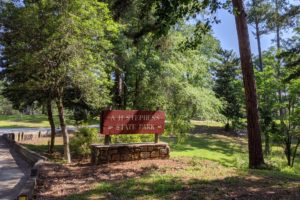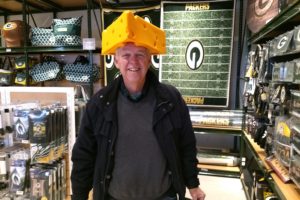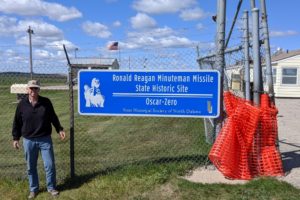In a high valley of the Sierra Nevada, close to the Nevada state line, is Bodie State Historic Park that shows us what this mining town from the 1880s looked like when the state park system took over in 1962. It’s cold and windy today, so be sure to bundle up and wear comfortable shoes as we walk around.

What’s so interesting in Bodie is that the buildings are just as they were in 1962 when California designated the town as a California state park. Only about 5% of the buildings remain from the town’s 1877-1881 heyday; most are gone because of time, fire, and the elements. The state’s goal is to keep buildings in a state of “arrested decay,” which means their roofs, windows, and foundations are repaired to how they were in 1962 rather than being restored.
The homes and stores here are just as they were when people left over the years because it was cheaper to buy new items somewhere else than pay to transport furniture and household items elsewhere. Don’t be surprised by the torn wallpaper and turned over furniture. Mining continued until 1942 so people were around, and the family of Bodie’s last major landowner hired caretakers to watch over the town and protect it from looters and vandals, which is why the town is in as good condition as it is.
Much of the information in this post is from a detailed brochure we picked up at the entrance; it was really helpful in giving context as we walked around.
driving into Bodie
Bodie is 13 miles east of US-395 that we’ve been driving north on since Lone Pine just south of Bridgeport (more about Bridgeport in the next post). The last 2.7 miles is a rough dirt road, giving us the idea of what it would have been like for the miners and townspeople trying to get to Bodie with their supplies.

of the road is actually just before we got to Bodie, but I have a lot of admiration for the people who came here with the desire to make a new home along with their fortunes.

some background first





The families and more community-minded residents gathered at the middle and south end of town. They had a parade on the 4th of July for the families, had a band that played, and watched children play games. The men competed in hard rock “drilling” contests, and wrestling competitions were frequent. Couples enjoyed fancy dress balls at the Miners’ Union Hall, which doubled as a social center. Children’s recitals, concerts, and other social events kept the “proper” women busy planning. A horse racing track was set up in a flat area south of town, and the town had a baseball field where the “Bodie Mutts” played ball.
Interesting that few buildings on the north end of town survived the fires in 1892 and 1932. What we’ll be seeing is more of the middle of town heading south.
Let’s start exploring

D.V. Cain family; the Cains sold Bodie to California State Parks in 1962.
David Cain’s father is the one who really established Bodie,
and we’ll see his home soon. This home is now one of the residences for state park employees, and a few others are scattered around town. Three employees live in Bodie full-time now, watching over the area. Can’t image living here during the winter, but they do have heat and electricity. More staff come in for the summer, and we’ll meet one as we walk along.
We saw the Methodist Church in the first picture of the post; here’s the inside.

The Catholic church, also built the same year, burned in 1928.


It now houses a room showing a video of Bodie made from
photographs of the time.

Tom Miller moved here from Canada and worked as a teamster for the Bodie Railway and Lumber Company near Mono Mills (remember the previous post?). In 1900, Miller and his wife, Jessie, lived here with their
2 children. We get to see the inside of this nice home in the next few pictures. This is the only house where we got to walk up the stairs and walk around inside.





the wallpaper and bed covering work together


cloth, newspaper, and finally wallpaper

an accent border along the ceiling just like we used in the 1980s!

25 years old and had just married a woman from Genoa (we’ll be
there in a couple of posts). He started out in the lumber business and
put barges and a steamship on Mono Lake to transport wood. (Boats
on the lake? Amazing.)
In 1888 Cain became a banker and kept the Bodie bank open until 1932. In 1915 he acquired the Standard Company mining properties through court action and soon became the principal property owner in town. He always thought Bodie would have another boon. His prosperity allowed him to have the beautiful glass-window porch on his home.



This hall was central to Bodie’s social life in 1878 in addition to be the meeting place for union members. The union was organized in December 1877 and joined the Western Federation of Miners as Local 61 in 1903. From the information in the town’s video, the union was able to improve conditions for the miners but was never able to raise their pay. Of course, since payroll taxes didn’t exist yet, when a miner earned $4 a day, he got all of the $4 to spend on himself.
Next to the union hall is the mortuary we just talked about.

The building on the left, one of the few brick buildings in town, housed the post office starting in 1879. The upstairs served as Grandma Johnson’s rooming house. Later the building became the DeChambeau Hotel. In Bodie’s final years, it was a bar and cafe.

mailbox holder was used by the town for its mail.

Horace Swasey was a Nevada rancher who bought this two-story
hotel in 1894. Later on it housed a clothing store and a casino.

Built in 1879, it was one of several general stores in town. The store
was owned by Harvey Boone, a distant cousin of Daniel Boone, and partner James W. Wright.



is in the middle of the picture; any ideas? More
full shelves after owners just up and left town.


They moved to Bodie in 1883. Their successful mining
investments allowed them to purchase houses and
several saloons. Let’s take a look inside their home.




and dad’s ties are hanging on the wall


The bar was opened in 1937 by Sam Leon after losing his U.S. Hotel
in the 1932 fire. This building was previously a restaurant. Leon was
born in China in 1879; he also ran cafes and boarding houses in Bodie.



the last barber to work in Bodie. The barber chair is
on the left, and a shoeshine chair is on the right

This firehouse was rebuilt in the 1930s by the CCC. Volunteer firefighting companies battled a number of fires over the years; largest were on
July 25, 1892, and June 23, 1932.
The 1892 fire started on Main Street in a restaurant and burned about 60 buildings. A valve closed by mistake hampered fighting the fire. Lack of water also was a problem in the 1932 blaze because poorly maintained screens at the reservoir caused rocks and debris to clog the pipes.

This building was originally the Bon Ton Lodging House. It became a school after the first school was allegedly burned down by an early-day juvenile delinquent. The school saw its highest enrollment of 615 in 1879-1880. It closed in 1942.


Dr. John Street was a physician for the Treadwell-Yukon Mining Company between December 1930 and January 1932. In Bodie’s boom years, a number of doctors in private practice were kept busy with victims of mining accidents, smallpox, cholera, and pneumonia.

see the exam table on the left?



Frank Quinville from Canada moved to Bodie in the 1880s. He was
the blacksmith for the Standard Mine and Mill into the 1900s.
He and his wife, Mary, had five children in this home.




This company was the most successful of the 30 mining companies operating in the Bodie Mining District. Heavy iron rods known as stamps broke up quartz rock containing gold and silver. Mercury (and later cyanide) was used to separate the metals from the crushed rock. Can you imagine all the trial and error it took to figure out this process?
Standard Mine was on the hill above the stamp mill. A mine collapse in 1875 revealed a rich ore vein and started the rush to Bodie. The mine was renamed from Bullion Mine to Standard in 1877 and yielded more than $18 million over 38 years. This mill was built in 1899 after an 1898 fire destroyed the original building.
In 1893 Superintendent Thomas Leggett brought electricity to power the mill from a hydroelectric plant about 13 miles away—one of the first long-distance transmissions of alternating current in the U.S.

Hoover and his family lived here from June 1903 to January 1906. He later because head of mining and metallurgy department at Stanford University, his alma mater. This long porch provided them a beautiful view of the valley, but the noise from the stamp mill and the mines must have almost driven them crazy since they were so close by.

Looks like they had a covered roof along the front of the house
and around the corner.

Now back down the hill to the north end of town.

Membership in Lodge No. 252 peaked at 93 in 1882; it was established
in 1878. Later in 1918, the lodge consolidated with one in nearby
Bishop (we’ve been there!).
The laundry was originally on Bonanza Street, parallel to
Main Street and part of the notorious north end of Bodie but also
close to Chinatown.



All that remains after the 1932 fire is the brick vault. James Cain
bought the bank in 1890. Despite Bodie’s wild west reputation, the
bank was never robbed. However, a nighttime burglary in
September 1916 yielded $2000 in cash, some bullion, and other valuables.

as one of the many stone warehouses to house supplies during the
long, cold Bodie winters.



Hundreds of horses, oxen, and mules pulled wagons that hauled tons of goods in Bodie’s busiest years. Stewart Kirkwood, who owned this
stable, also housed a blacksmith shop where the animals were shod.

This town jail looks so small in proportion to tales of lawlessness
during Bodie’s boom years. In the town’s video, the originator said
most conflicts were settled by gun battles where lots of bullets were
shot but few injuries happened. But then there’s the infamous 1881 incident after which Constable John Kirgan was temporarily demoted.
Vigilantes had taken accused murderer Joseph DeRoche from the jail and hanged him. Here’s the rest of the story.
Early on January 14, 1881, miner Thomas Treloar was shot and killed at the corner of Main and Lowe Streets. Witnesses said DeRoache, who was romantically involved with Treloar’s wife, shot Treloar as he left a dance at the Miners Union Hall. DeRoche was arrested but escaped a few hours later. A posse recaptured him 2 days later and brought him to the jail in Bodie. After midnight, a vigilante committee—known in mining camps as “601”—took DeRoche and hanged him. Wonder what happened to the wife?

Located conveniently behind Main Street saloons was Bonanza Street, also known as Maiden Lane (like in San Francisco) and Virgin Alley (such attempts at humor). This street had a row of mostly one-room cabins, called “cribs,” for the ladies of the night to work and live.
Further north on the street, do you see the crumbling building with a brick foundation? That’s the remains of the Maestretti Liquor Warehouse, named for Antone Maestretti. He was a native of Switzerland and owned a saloon and a bakery in Bodie. He even took a turn as a constable in 1880.
Chinatown
To the east of the previous picture is the town’s Chinatown. With several hundred people in their community, the Chinese created a town within the town so they could maintain their own customs and traditions, especially since they weren’t welcome members of the white society. The Chinese quarter offered residents a full range of services, such as general stores, laundries, gambling halls, saloons, boarding houses, and a Taoist temple. Opium dens were frequented by all. Their main source of income came from selling vegetables, operating laundries, making charcoal, and working on the Bodie railway.
Phew, we’re done. These are just some of the homes and businesses we saw in Bodie. If you ever get a chance to go, please do. It’s a real “must see.” Before we finish, however, I want to show you a view of Mono Lake that we saw as we were leaving. It really is close to Bodie!





